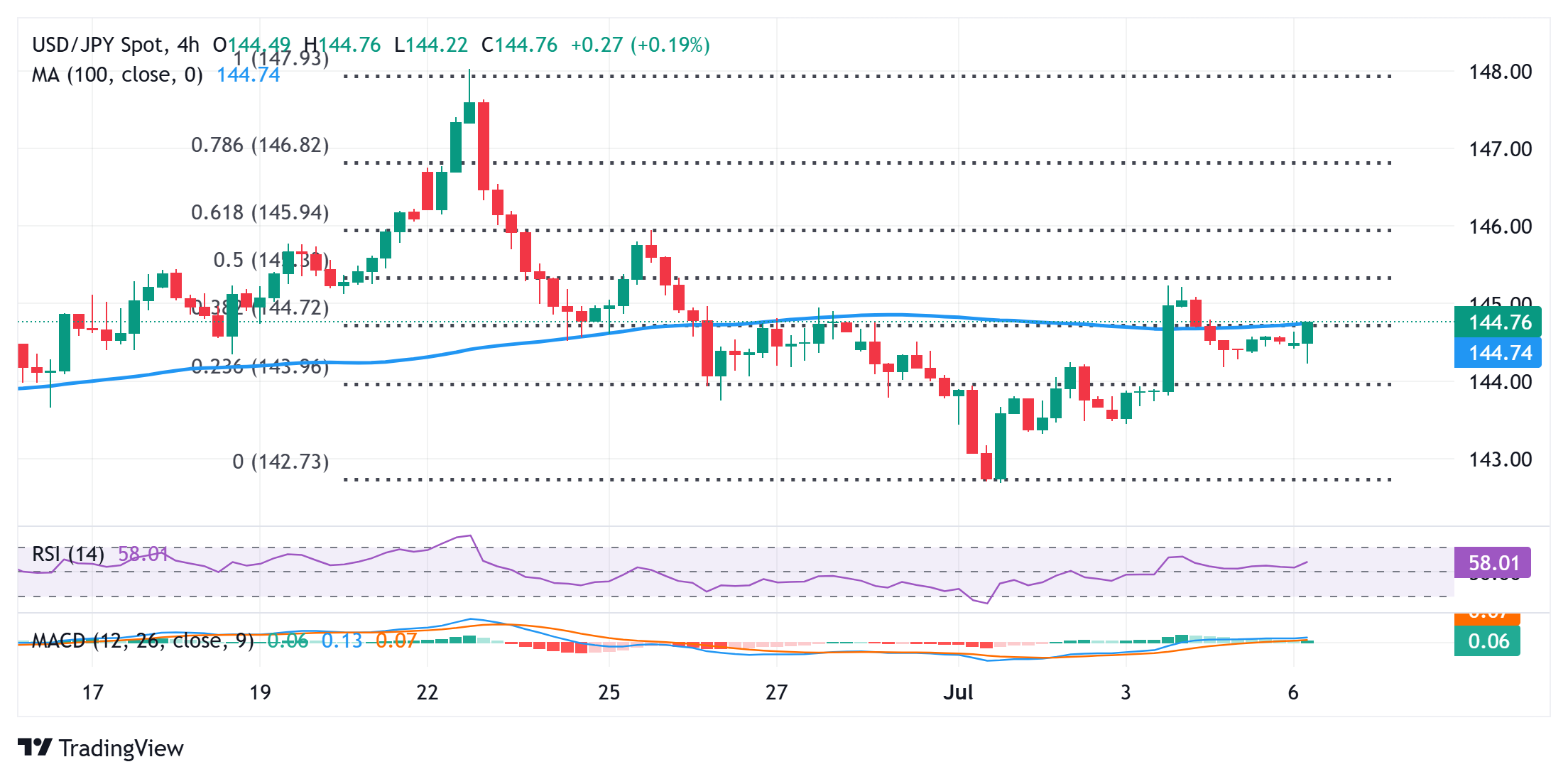
- The Japanese Yen drifts lower in reaction to weaker domestic wage growth data.
- Geopolitical risks and divergent BoJ-Fed expectations should limit JPY losses.
- The USD bearish sentiment might further contribute to capping the USD/JPY pair.
The Japanese Yen (JPY) intraday selling bias against a broadly stronger US Dollar (USD) remains unabated, with the USD/JPY pair holding above the 145.00 psychological mark through the early European session on Monday. Investors remain worried that global trade tensions triggered by US tariffs could complicate the Bank of Japan’s (BoJ) efforts to normalise monetary policy. Apart from this, weaker domestic data, showing that real wages in Japan fell for the fifth straight month in May and at the fastest pace in nearly two years, turns out to be another factor undermining the JPY.
Despite the negative factors, the growing acceptance that the BoJ will hike interest rates again might hold back the JPY bears from placing aggressive bets. This marks a big divergence in comparison to expectations that the Federal Reserve (Fed) will resume its rate-cutting cycle in the near future, which might cap the upside for the USD and support the lower-yielding JPY. Furthermore, geopolitical risks stemming from Israeli strikes on three Yemeni ports early this Monday and the uncertainty over Trump’s erratic trade policies might contribute to limiting losses for the safe-haven JPY.
Japanese Yen remains depressed as trade jitters offset hawkish BoJ expectations
- The Israeli military carried out intense strikes on Houthi targets in three Yemeni ports and a power plant early this Monday in response to repeated attacks by the Iran-aligned group on Israel. This marks the first Israeli attack on Yemen in almost a month and should drive safe-haven flows towards the Japanese Yen.
- Government data released earlier today showed that Nominal Wages in Japan rose 1% in May 2025 from a year earlier, marking the third straight month of deceleration and falling well short of market expectations. This was also the weakest growth since March 2024 amid an 18.7% plunge in special bonus payments.
- Adding to this, inflation-adjusted real wages posted the steepest decline in 20 months and fell 2.9% YoY in May compared to a revised 2.0% drop in the previous month. Meanwhile, the consumer inflation rate that the labour ministry uses to calculate real wages climbed 4.0% YoY during the reported month.
- The data fueled concerns that stagnant real incomes could dampen consumer spending and stall broader economic recovery amid heightened uncertainty over US President Donald Trump’s new tariffs. This might complicate the Bank of Japan’s path to normalising interest rates and capping gains for the JPY.
- The US Dollar, on the other hand, struggles to register any meaningful recovery from a multi-year low touched last week amid relatively dovish Federal Reserve expectations. In fact, traders are pricing in over a 70% chance of a rate cut in September and at least two 25 basis points rate reductions this year.
- Investors now look forward to the release of the FOMC meeting minutes on Wednesday for fresh cues about the Fed’s policy outlook and rate-cut path. This, in turn, will play a key role in influencing the near-term USD price dynamics and providing some meaningful impetus to the USD/JPY pair.
USD/JPY bulls might wait for move beyond 145.25-145.30 before placing fresh bets

Momentum beyond the 144.65-144.70 confluence – comprising the 100-period Simple Moving Average (SMA) on the 4-hour chart and the 38.2% Fibonacci retracement level of the June-July downfall – would be seen as a key trigger for the USD/JPY bulls. The subsequent move up could allow spot prices to reclaim the 145.00 psychological mark and test the 145.25-145.30 supply zone. A sustained strength beyond the latter should pave the way towards the 61.8% Fibo. retracement level, around the 146.00 round figure.
On the flip side, the Asian session low, around the 144.20 horizontal zone, could offer some support ahead of the 144.00 round figure, or the 23.6% Fibo. retracement level. A convincing break below might shift the bias back in favor of bearish traders and drag the USD/JPY pair to the 143.45 intermediate support en route to the 143.00 mark. The downward trajectory could extend further towards the 142.70-142.65 region, or a one-month low touched last Tuesday.
Tariffs FAQs
Tariffs are customs duties levied on certain merchandise imports or a category of products. Tariffs are designed to help local producers and manufacturers be more competitive in the market by providing a price advantage over similar goods that can be imported. Tariffs are widely used as tools of protectionism, along with trade barriers and import quotas.
Although tariffs and taxes both generate government revenue to fund public goods and services, they have several distinctions. Tariffs are prepaid at the port of entry, while taxes are paid at the time of purchase. Taxes are imposed on individual taxpayers and businesses, while tariffs are paid by importers.
There are two schools of thought among economists regarding the usage of tariffs. While some argue that tariffs are necessary to protect domestic industries and address trade imbalances, others see them as a harmful tool that could potentially drive prices higher over the long term and lead to a damaging trade war by encouraging tit-for-tat tariffs.
During the run-up to the presidential election in November 2024, Donald Trump made it clear that he intends to use tariffs to support the US economy and American producers. In 2024, Mexico, China and Canada accounted for 42% of total US imports. In this period, Mexico stood out as the top exporter with $466.6 billion, according to the US Census Bureau. Hence, Trump wants to focus on these three nations when imposing tariffs. He also plans to use the revenue generated through tariffs to lower personal income taxes.
Information on these pages contains forward-looking statements that involve risks and uncertainties. Markets and instruments profiled on this page are for informational purposes only and should not in any way come across as a recommendation to buy or sell in these assets. You should do your own thorough research before making any investment decisions. FXStreet does not in any way guarantee that this information is free from mistakes, errors, or material misstatements. It also does not guarantee that this information is of a timely nature. Investing in Open Markets involves a great deal of risk, including the loss of all or a portion of your investment, as well as emotional distress. All risks, losses and costs associated with investing, including total loss of principal, are your responsibility. The views and opinions expressed in this article are those of the authors and do not necessarily reflect the official policy or position of FXStreet nor its advertisers. The author will not be held responsible for information that is found at the end of links posted on this page.
If not otherwise explicitly mentioned in the body of the article, at the time of writing, the author has no position in any stock mentioned in this article and no business relationship with any company mentioned. The author has not received compensation for writing this article, other than from FXStreet.
FXStreet and the author do not provide personalized recommendations. The author makes no representations as to the accuracy, completeness, or suitability of this information. FXStreet and the author will not be liable for any errors, omissions or any losses, injuries or damages arising from this information and its display or use. Errors and omissions excepted.
The author and FXStreet are not registered investment advisors and nothing in this article is intended to be investment advice.






